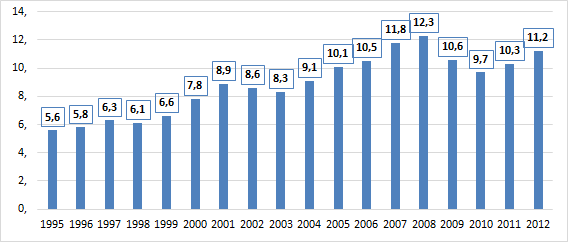Electricity Tariffs Grow Faster than Inflation
25.05.2014
Russian citizens have to give away a significant part of their income for utility charges. The share of electric power in the structure of payments was about 16% in 2013. On the whole, 80% of utility tariffs go for hot water, heat, gas and electricity supplies. According to a research by Intesco Research Group “Market of Energy Saving in Power Industry. Current Situation and Forecast”, the share of mandatory payments in the structure of expenditure of Russian citizens in 2012 made up 11.2%, the highest figure was recorded in 2008 – 12.3%. At the same time, in 1995 the given indicator did not exceed 5.6%.
Schedule. Dynamics of the share of expenditure on mandatory payments in Russia in 1995-2012, %

Source: Federal Service of State Statistics, Intesco Research Group
The annual growth rate of tariffs for utility services exceeds inflation growth rates almost twice. The state, in its turn, tries to control this mismatching: for example, in 2014-2016 it is expected that tariffs for the population will be established while taking into account the decreasing coefficient based on the inflation in the previous period. Starting from 2017, it is suggested that gas and electric power tariffs for the population should be adjusted based on the ratio of 1.1-1.3 of inflation level exceeding, till reaching the European ratio of electric power tariffs for industrial consumers and the population. However, such a comparison will not be in favour of Russian citizens.
Indeed, Russian population pays for electricity less than in European countries and the USA; however, one should not forget that Russian citizens’ incomes are also significantly lower. One should note that the lowest electric power tariffs in Russia are recorded in the Siberian Federal District, while in Europe – in the territory of Bulgaria and Estonia. The highest payment for electricity is in the Central Federal District, while the most ‘expensive’ countries are Great Britain, Norway and Germany.
Should Russian citizens pay for electricity as much as European population, their incomes will hardly cover utility payments. Besides, the share of commercial losses of electric power will increase, people will start to use electric power illegally.
Thus, the effectiveness of a transfer of Russian prices to the European level, even in the long-term perspective, gives ground for doubt.
The given figures were calculated by analysts of Intesco Research Group based on the official statistics.

